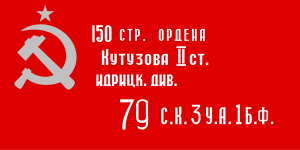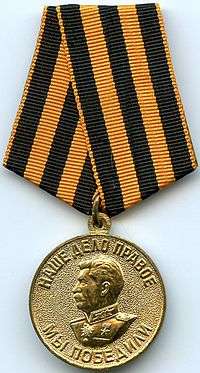Victory Banner
The Soviet Banner of Victory (Russian: Знамя Победы, romanized: Znamya Pobedy) was the banner raised by the Red Army soldiers on the Reichstag building in Berlin on May 1, 1945, the day after Adolf Hitler committed suicide. It was raised by three Soviet soldiers: Alexei Berest, Mikhail Yegorov, and Meliton Kantaria.

The Victory Banner, made under battlefield conditions, is the official symbol of the Victory of the Soviet people against Nazi Germany during the Second World War. It is also one of the national treasures of Russia. The Cyrillic inscription reads:
150th Rifle, Order of Kutuzov 2nd class, Idritsa Division, 79th Rifle Corps, 3rd Shock Army, 1st Belorussian Front.
Although this flag was not the only one to be hoisted on the Reichstag, it was the first and only survivor of all the "official" flags specially prepared to be raised there.
According to the Law of the Russian Federation, the Banner of Victory is to be stored forever in a place which provides its safety and public availability.
Origin
|
Report of the commander of the 3rd assault army to the head of political administration of The Red Army about the fight for Reichstag and placing the Victory Banner on it. (quotes)[1] July 2, 1945. The Commander of the 1st Byelorussian Front Marshal of Soviet Union comrade Zhukov ordered the troops of 3rd assault army headily enter Berlin, to secure the downtown and Reichstag and to place the Victory Banner on it. <...> Having defeated the last enemy strongholds the troops of the army entered Berlin at 6:00 o'clock in the evening on the 21st of April 1945. <...> After seizing the downtown the troops of the 3rd assault army penetrated the neighborhood of the Reichstag at the end of 29 of April 1945.. On the 30th of April with the sunrise they started the massive assault on Reichstag. <...> On the 30th of April 1945 at 14:25 (2:25 pm) the fighters of superior corporal Syanov's group fought their way to the roof and reached the dome. The courageous warriors - Communist Lieutenant Berest, Comsomol Member Soldier Egorov and member of no party Junior Corporal Kantaria have set the banner, the symbol of our Great Victory, the Proud Flag of the Soviet Union flew above the German Parliament building! The burned and pierced by bullets Banner was victoriously flying above defeated Berlin <...> The Commander of the troops of the 3rd Assault Army, Soviet Union Hero, Colonel-General Kuznetsov Member of Military Board of the 3rd Assault Army Major-General Litvinov |
Yeltsin's Victory Banner

There was a variation of the Soviet flag, without the hammer and sickle, to which president Boris Yeltsin gave a status similar to that of the national flag, on April 5, 1996. President Vladimir Putin also adopted the Victory Banner as the official flag of the Russian Army. This flag was named after the flag raised on the Reichstag, but it is also called Victory Flag.
Today this variation is no longer an official symbol. The Russian Ground Forces flag was once again changed to a flag without the Soviet-era star.[2][3]
The flags to be used for celebrations of the Soviet Victory Day were defined by a federal law.[4]
Events with the banner
On May 9, during Victory Day parade in Moscow, a copy of Victory Banner #5 is carried immediately behind the Russian flag by members of the Moscow Commandant's Regiment Honor and Colors Guards. (In 2015 the order was reversed.) During the Independence Day Parade and the Victory Parade in Minsk, the color guard consisting of the Flag of Belarus, the Victory Banner and the Flag of the USSR are the first to march in the parade. The Victory Banner was brought to Kiev from Moscow in October 2004 to take part in the parade in honor of the 60th Anniversary of the Liberation of Ukraine.[5] This is the first instance of Russia sending the banner to a former Soviet Republic. In 2015, the banner was brought to Astana (the capital of Kazakhstan) to be trooped through Kazakh Eli Square by personnel of the Aibyn Presidential Regiment in the Defender of the Fatherland Day parade on 7 May.[6] In 2020, during the first Victory Parade held in Ashgabat, the Banner was brought from Russia to be trooped on the square near the Halk Hakydasy Memorial Complex.[7] That same year sailors of the Northern Fleet raised the banner over distant parts of the Russian Arctic.[8]
See also
- Order of Victory
- Victory Day (May 9)
- Raising a flag over the Reichstag
References
- Russian archive: Second World War: B. 15 (4-5). Fight for Berlin (Red Army in the defeated Germany).— M.: Terra, 1995. Chapter III. «Banner above Reichtag»
- "Флаги". Archived from the original on 2007-12-10. Retrieved 2007-12-02.
- Федеральный закон Российской Федерации «О знамени Вооруженных Сил Российской Федерации, знамени Военно-Морского Флота, знаменах иных видов Вооруженных Сил Российской Федерации и знаменах других войск»
- Федеральный закон Российской Федерации от 7 мая 2007 г. N 68-ФЗ "О Знамени Победы"
- https://sputniknews.com/onlinenews/2004102639771985/
- "Historic Scenes, Retro Military Equipment to be Presented in Victory Parade - The Astana Times". The Astana Times. 2015-04-24. Retrieved 2017-10-20.
- http://en.kremlin.ru/events/president/news/63347
- http://www.kxan36news.com/military-sailors-of-the-northern-fleet-will-raise-the-victory-banner-over-the-arctic?amp

